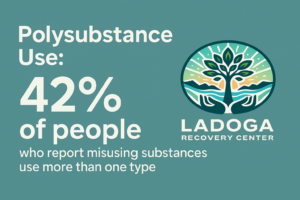I didn’t set out to develop a problem. I wasn’t chasing some wild high or spiraling out every weekend. I was just… coping. A couple of drinks to loosen up. A painkiller to quiet the physical stuff. A stimulant when I needed to power through. It felt like maintenance, not misuse.
But over time, the mix became the norm. It wasn’t just wine. It was wine and something else. Something to lift me. Something to slow me down. Something to take the edge off the thing that took the edge off. And somewhere in all of it, I started losing track of who I was.
If you’re here because you’re wondering if this is a real problem—let me say this: wondering is enough. You don’t need to be sure. You don’t need a label. You just need a little room to look at it honestly. I’m glad you’re here.
What Counts as Polysubstance Use?
Polysubstance use means using more than one substance—intentionally or not. A common example? Drinking alcohol while taking anxiety meds, or combining stimulants and opioids to manage both energy and pain. It can look like partying. It can also look like surviving.
For a long time, I told myself, this doesn’t count. I wasn’t blacking out. I wasn’t getting high in an alley. I was managing stress, or so I thought. But the truth is, when multiple substances interact in your system, the risk increases—whether or not you think you “look” like someone with addiction.

How It Sneaks Up on You
At first, I only used when I was overwhelmed. Then I used to feel “normal.” Eventually, I wasn’t sure what sober even felt like.
The hardest part? I still looked functional on the outside. I kept my job. I went to birthday dinners. But inside, I felt like I was playing a version of myself that didn’t quite match. I was scared someone would notice. But I was also scared no one would.
It didn’t feel dramatic enough to be addiction. But it didn’t feel safe, either.
Signs You Might Be Dealing With Polysubstance Addiction
Not all signs are loud. Some are quiet. Subtle. Easy to justify. But they matter. Here are a few I wish I’d paid attention to earlier:
-
You feel like you need “just a little something” to take the edge off almost every day.
-
You’re mixing substances (even casually) more often than you used to.
-
You’ve noticed your tolerance going up—you need more to get the same effect.
-
You’ve had scary experiences (memory gaps, panic, physical symptoms) and still went back to it.
-
You downplay it to others—or hide it altogether.
-
You feel like a different person than you used to be.
If any of this sounds familiar, it doesn’t mean you’re broken. It just means it’s time to look more closely.
The Shame Loop No One Talks About
There’s a unique shame that comes with feeling like you might be misusing substances—but you’re not sure if it’s “bad enough”. You compare yourself to extremes and tell yourself it’s not a real problem. But deep down, you know something’s off.
That shame can keep you silent for years. It did for me. I thought asking for help meant admitting failure. But the truth is, staying silent was what kept me stuck.
What Polysubstance Addiction Treatment Actually Offers
When I finally reached out, I expected judgment. I got the opposite.
At Ladoga Recovery Center here in Indiana, treatment didn’t start with labels—it started with listening. They helped me unpack why I was using, not just what. It wasn’t just about stopping. It was about healing.
Polysubstance addiction treatment might include:
-
Medical detox, if your body has become dependent on certain substances
-
Outpatient or residential care, depending on your needs and stability
-
Individual therapy to address the root causes—stress, trauma, pain, anxiety
-
Group support, where you can hear stories that make you feel less alone
I used to think I needed to be “worse” to deserve help. Now I know better: you don’t have to hit bottom to choose something better.
Why Indiana Is a Place Worth Starting From
Whether you live in Indianapolis, Fort Wayne, or anywhere in between, know this: Indiana has resources, and Ladoga is one of them. It’s not about escaping your life—it’s about finding people here who can help you make sense of it.
Recovery isn’t about becoming someone new. It’s about coming home to who you’ve always been, underneath the coping.
FAQ: Mixing Drugs and Alcohol
Is mixing substances always dangerous?
Not always, but often. Some combinations can be especially risky—like alcohol with benzodiazepines or opioids, which can slow your breathing. Even “casual” mixing can increase overdose risk or lead to dependency.
Can I get treatment if I’m not addicted but just concerned?
Yes. You don’t need a diagnosis to seek help. If you’re feeling uneasy or questioning your use, that’s a valid reason to reach out.
What if I’m still functioning—does that mean I’m fine?
Functioning isn’t the same as thriving. You can “keep it together” on the outside and still be hurting inside. If substance use is becoming a regular part of your emotional survival, it’s worth exploring that.
What makes polysubstance treatment different?
It accounts for how multiple substances affect your body and mind—and how they often tie into deeper emotional pain. The treatment is more holistic, more careful, and more customized.
Is help available near me in Indiana?
Yes. Ladoga Recovery Center offers personalized care right here in Indiana. Whether you’re local or from a nearby town, support is close by—and ready when you are.
You’re Allowed to Ask for More
If you’re silently struggling, I see you. I’ve been you. And here’s what I wish someone had said to me sooner:
You don’t need to collapse to ask for care. You don’t have to justify your pain. If you’re wondering whether this path you’re on is safe or sustainable, that wondering alone is worth honoring.
Feeling ready to talk it through? Call Ladoga Recovery Center at (844) 628-6202. We’ll meet you wherever you are. No pressure. Just people who understand what it’s like to wonder—and who know what’s possible on the other side.

